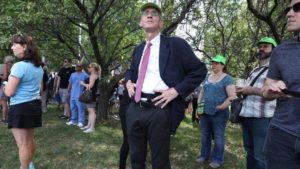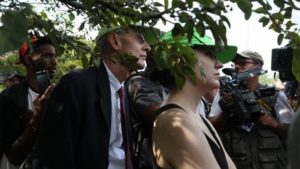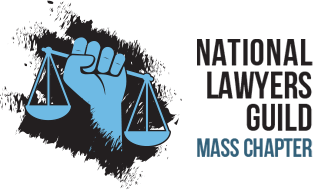from The Chicago Tribune, posted on Tuesday, August 28, 2018.
They’re watching, whether the whole world is watching. Legal observers in green hats are part of Chicago protests.
By Christopher Borrelli

National Lawyers Guild Legal Observer Millicent Hoffman watches the scene on Lake Shore Drive at Belmont Avenue during an anti-violence protest, Aug. 2, 2018, in Chicago (John J. Kim / Chicago Tribune)
The first lawyer to arrive stood, as usual, at the edge of the protest. He waited and watched the police as the police watched the protesters, who readied themselves to march, ignoring long silent rows of officers. He fingered his notebook, but generally he didn’t take notes — he didn’t want to look down and miss anything. The lawyer wore the same green baseball cap he wore to every protest, and since he had been watching the police watch protesters for many years, that hat was faded from sun.
This was early August, at a corner in Lakeview, as organizers of an anti-violence march prepared to shut Lake Shore Drive. The attorney, Jerry Boyle, a longtime Chicago trial lawyer, had come straight from his office. Aside from the green hat, he wore a pinstriped suit and a necktie. If he needed to move through a police blockade, he reasoned, “they might move aside for a cornfed white boy in a suit, because that’s how power works in this culture.” But he wasn’t expecting trouble. Protesters and their children were drawing on the road in chalk, some officers were bending over to casually admire the artworks.
“It’d be bad optics to mess with this,” Boyle said.
Then he gave a toothy smirk: “But you never know until you arrive!”
Boyle is a Legal Observer with the Chicago chapter of the National Lawyers Guild, an 81-year-old organization of left-leaning lawyers who support progressive causes, founded as a counterweight to the famously conservative American Bar Association, which excluded African-Americans from membership until 1943.
There are about 100 Legal Observers with the Chicago chapter, trained volunteers whose job is to watch police during a protest, record any alleged violations of civil liberties and, according to the group’s directive, serve “as a deterrent to unconstitutional behavior.”
They wear green hats with “Legal Observer” stitched across the front — in fact, the guild, which keeps its national headquarters in New York, trademarked the phrase “Legal Observer.” If you attended a protest in the past 50 years, there is good chance a Legal Observer was watching. More than 50 watched NATO protests in Chicago in 2012; almost as many watched local marches in the days after Donald Trump’s inauguration.

National Lawyers Guild Legal Observer Jerry Boyle watches the scene near Lake Shore Drive at Belmont Avenue during an anti-violence protest, Aug. 2, 2018, in Chicago. (John J. Kim / Chicago Tribune)
The NLG Legal Observer program is also a byproduct of the most infamous use of force against a political demonstration in Chicago history, the police beatings of protesters and bystanders around Grant Park during the 1968 Democratic National Convention. That chaos is well-known: Supervisors dragged flailing officers off pedestrians, clouds of tear gas wafted into the hotel suite of Vice President Hubert Humphrey, local officials were accused on the convention floor of using “Gestapo tactics” in the name of crowd control. A federal report would later call what happened in Grant Park a “police riot.”
By August 1968, though, after years of civil rights and Vietnam War marches ending in police clashes and mass arrests, protesters were looking for regular, legal rule keepers to watch from the margins. The NLG’s observer program got its feet wet in Grant Park.
“My job with the Lawyers Guild was to mobilize law students to help out (as observers),” said Bernardine Dohrn, a former assistant law professor at Northwestern University and member of the militant group the Weather Underground. “They were to get names of police and anyone arrested, watch how people were treated. It was kind of predictable. I think it’s safe to say we didn’t have much impact that day in terms of restraining police.”
Fifty years later, NLG Legal Observers — which the organization estimates are 60 percent of its 3,000 members nationally — still work at the sidelines. They take notes on intimidating behavior and perceived abuses of power, they scurry for the names of protesters being arrested, they serve as eyewitnesses should a civil or criminal trial arise out of an arrest at a protest. But primarily, Legal Observers reiterate, their goal is expectedly passive, to serve as a silent reminder to the police that a lawyer is watching.
Having lawyers in green hats has become an “absolute must-have” on the checklist of any group in Chicago that is planning any size demonstration, said Andy Thayer of the Chicago Committee Against War and Racism. “It might seem unnecessary in the days of cellphone cameras, but that second set of eyes serving as witness, acting as a neutral party? It’s comforting to know they’re there. I mean, I’ve had situations where police want to take you aside to talk to you, and oh, no, no — I want them to do it out in the open, where someone in a green hat can monitor what police are doing and saying.”
“I think of Legal Observers as the unsung heroes of American democracy,” said L.A. Kauffman, a longtime activist and historian of protest movements. “In an ideal world, authorities are there to watch your First Amendment rights. Which sometimes happens. But over and over, police adopt a repressive role. I’ve been a (protest) organizer since the early ’80s — you see green hats, you know they’ll help to de-escalate any tensions.”
Moments before marchers stepped onto Lake Shore Drive, as warmup speeches were intensifying and rhetoric was flying out of huddles of protesters, a deputy police chief approached Boyle. He extended his hand: “Jerry!” he said. “How’s your health?”
“Thought you’d be here,” Boyle replied, smiling. “You know how to handle crowds.”
They chatted, caught up on life, the officer walked off, the march began.
“You never do know what you’ll get,” Boyle said to himself.

National Lawyers Guild Legal Observers Jerry Boyle and Millicent Hoffman watch the scene near Lake Shore Drive at Belmont Avenue during an anti-violence protest, Aug. 2, 2018, in Chicago. (John J. Kim / Chicago Tribune)
Sometimes protesters clear space for Legal Observers. Sometimes marchers thank them for being there. And sometimes Legal Observers get arrested themselves, swept up alongside the protesters. Janine Hoft, a lawyer with the People’s Law Office and Legal Observer since 1984, said: “I remember a demonstration at Clark and Adams in 1988. I heard a 15-year-old was being arrested who had never been arrested before, so I got closer to the paddy wagon and the officer said, ‘What are you doing here?’ And I explained. He said, ‘Oh, you want a closer look inside?’ Whoosh — I was being arrested.”
Much of the time, Legal Observers attend a protest virtually unnoticed, many protesters and police alike having little idea of what they do. Kofi Ademola, a Chicago activist and adult mentor for the student-led GoodKids MadCity, said: “Especially if you’re protesting as a teenager, you often don’t know who’s watching out and you often don’t even know your rights, so to know someone is there to see Miranda rights read and someone will be there to follow up (on your arrest) — they are definitely a deterrent to misconduct.”
Legal Observers are usually lawyers, law students or legal assistants. They get the correct spelling of the name of a person being arrested (a bad spelling wastes time), they contact family members about arrests, they monitor immigration raids, they hand out know-your-rights cards, they even warn activists of suspected undercover police.
“Actually, since the election (in 2016), we’ve had a huge surge of interest,” said Sharlyn Grace, local coordinator for the observer program. Nationally, NLG membership has added a thousand members since late 2016. Locally, the group says it is getting as many as 10 requests a month to monitor demonstrations in Illinois. “You might say we’re busy.” (Indeed, a recent Washington Post/Kaiser Family Foundation poll found almost 20 percent of Americans have participated in a protest or march since early 2016.)
In August 1968, though, the Chicago chapter of the Lawyers Guild was still rebounding from its relative obscurity during the McCarthy era, when the group was often regarded as a Communist front. For decades it had been investigated by J. Edgar Hoover’s FBI. By the time of the DNC, having Legal Observers monitor authorities “felt like a new idea and a very old idea,” Dohrn said. Martin Luther King Jr. and Robert Kennedy had been assassinated, sit-ins occupied colleges and protesters were descending on Chicago. Months of rioting and demonstrations appeared to be coming to a head. According to David Farber, a University of Kansasprofessor and author of the history “Chicago ’68,” antiwar protest organizers decided as early as January to have legal watchers on hand.
There were civilian observers at the 1963 March on Washington; for years, the Black Panthers designated members to watch police behavior during its own protests. “The NLG were not that formal by the time of Grant Park,” Farber said. “They certainly didn’t see their primary job as watching for misconduct. They figured if they saw an arrest, they intervene. But like a lot of observers at the DNC, once there they were shocked. Everyone knew how police handled African-Americans but the sense they would attack white protesters that way — I think you see there a lot of lawyers rethinking the role they would play. The truth is, they were thinking out loud and stumbling towards solutions.”
There were reportedly 10,000 protesters — and 12,000 police officers, 600 National Guard troops and 1,000 undercover cops. By the time the DNC was over there were 600 arrests and hundreds of injuries. The Lawyers Guild says it’s not certain how many observers it had in Grant Park, but many remember them: “I recall (Legal Observers) in the park,” said Don Rose, a Chicago political consultant who at the time was spokesperson for the National Mobilization Committee to End the War in Vietnam. “But I don’t recall them wearing green hats in ’68 — that would have definitely gotten the (expletive) beaten out of them.”
As Jerry Boyle scanned the crowd along Lake Shore Drive, more Legal Observers began arriving and tugging on their green hats and pulling out pens and notepads. Suddenly a protester walked up the off-ramp chanting “Shut it down! Shut it down!” A police officer moved close to the man and urged him to step off the road and onto the grass. “Don’t push me!” the man yelled at the officer. A moment later, as if he had been waiting in the wings, a man on a bike pedaled up, braked and shouted at the protester: “Don’t pretend like you didn’t come here to cause problems!” Police shifted. Boyle walked calmly to the protester and stood with his head down, as if studying grass.
The protester shouted at the counterprotester, who shouted back but won few sympathizers, and soon the protester walked off. But Boyle remained standing by the counterprotester, his head still down. He pulled out a cigarette and smoked and waited as the man watched the march coalesce. Then, after several minutes, Boyle held his phone in front of the man’s face and took his picture. The man did the same with Boyle.
Later the lawyer said, “Police are good at separating people, but this guy was baiting, and what if a crowd assembles then, what if police step in — we try to anticipate trouble.”
Since the ’68 DNC riot, Lawyers Guild observers have watched nearly every major protest in the United States. They have watched tenant rights marches and Black Lives Matter protests. They have helped bring cases against the police at the Standing Rock pipeline protests, and testified against police after protests in Ferguson, Mo., over a white police officer’s 2014 fatal shooting of a black teenager named Michael Brown. More than 30 watched police in Charlottesville, Va., during a 2016 white nationalists rally (which led to the founding of a local NLG chapter there). In Chicago, they have attended every major protest about the fatal shooting of Chicago teenager Laquan McDonald by Chicago police. And if anti-violence protesters shut down the Kennedy Expressway on Labor Day, as planned, there is a good chance that observers will be there, too.
In the 1970s they wore red hats; in the 1980s, during ACT UP protests regarding the White House’s handling of the AIDS crisis, they wore pink hats. This month, coming full circle, they are watching protests that mark the 50th anniversary of the ’68 protests.
Said Martin Stolar, a New York attorney well-known for having represented countless protesters since the Nixon administration: “I had a case once, after the Republican National Convention in 2000, where one of the key witnesses was a Legal Observer. Police had pinned about 40 demonstrators in a midtown street. They were charged with blocking traffic, a form of disorderly conduct, but because this guy was an observer, he testified how police had blocked the protesters off. So right observer in the right place, knowing they are there? It allows me to say to a prosecutor, ‘Look, don’t be an idiot. …’”
Stolar joined the Lawyers Guild in 1970, but in the years after the DNC riots, the guild’s handling of its observers and the defense of protesters “felt disorganized for a long while,” he said. The job of legal observation seemed vague even to observers, who at times were uncertain if they were acting as a witness to a protest or as a potential legal counsel.
“As we saw some police actions at protests get more militarized, there was a need to straighten and formalize the observer role,” said Pooja Gehi, executive director of the NLG. “We needed clarification.” In Chicago, where attorney Ben Meyer ran the program for a few years, “There was real need to approach this as one message, one purpose.”
After being stretched thin by the Occupy movement of 2011 and 2012, Meyer helped set new guidelines: Observers are legal watchers, not legal counsel. They do not negotiate between protesters and police. Requests for observers must be submitted (though the group is known to attend impromptu protests). Every observer goes through training, and no observer is allowed to protest alongside the people they are observing. Jim Fennerty, a Chicago attorney many credit with helping to mature the local observer program, said the system is so relatively streamlined now that some protest organizers send them a list of names of those planning to be arrested (with the correct spellings).
Yet observers don’t pretend to be politically neutral. They wouldn’t, say, provide Legal Observers for a white nationalist rally in Chicago — unlike the American Civil Liberties Union, which has its own, much smaller observer program (complete with orange hats).
Less certain is how observers are seen by authorities.
No Chicago observer has been arrested in years. Yet Grace, the local Legal Observer coordinator, said police have called her an ambulance chaser at protests (she said she can’t represent anyone she watches, so she can’t make a dime off them). She said, at a recent protest after the fatal shooting of a barber in the South Shore neighborhood in July, “one officer looked at me and read ‘Legal Observer’ on the front of my bright green hat and only then started shoving me. And I have never had that happen before.”
The local Fraternal Order of Police declined to comment for this article. A CPD spokesman, in an email response, noted the foundational tenets of the First Amendment (freedom of speech, freedom of the press, et al.), adding only that: “CPD protects those rights and makes every effort to support the safety of those expressing their rights.”
Indeed, a direct result of how police handled protests in the late 1960s, said Alex Vitale, coordinator of the Policing and Social Justice Project at Brooklyn College, “has been to professionalize police response to protests, to make it more flexible.” On the other hand, he said, the past 20 years has also seen the rise of “a RoboCop mentality. Chicago police understand the negotiated response, but also they know a heavy, confrontational response. And if you’re a Legal Observer in Chicago, who knows what you’re getting?”
As the march on Lake Shore Drive exited onto Belmont and continued toward Wrigley Field, helicopters hovered overhead; at the rear of the protest, police SUVs formed a dark, thick rolling wall. A half-dozen observers spread along across the long, flowing shape of the protest, staying close to clusters, walking at sides, staking out the back.
Observers watched and walked, talked among themselves, about the heat, the popularity of escape rooms, the Cubs, how much Chicago was spending guarding this march alone. At the corner of Addison and Clark, the protest stopped and held court, and Millicent Hoffman, who has been an observer since 2014, stayed close to the front. At Wrigley, fans lined the upper decks and some watched silently and some shouted insults. Then after an hour or so, the protest tapered off and the media packed up and no one was arrested. But Hoffman stayed until the very last protester. She has a rule: She goes go home when the protesters go home. Or she leaves when the police leave.



